Photos along the Blueway:
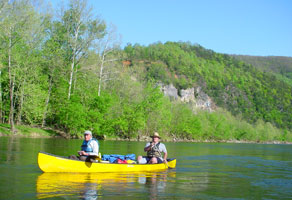
Canoeing along the river
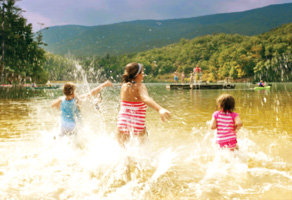
Swimming at Douthat Lake
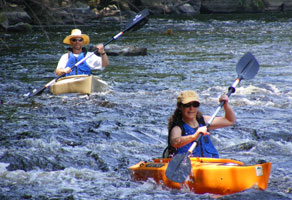
Paddling through rapids along the Blueway
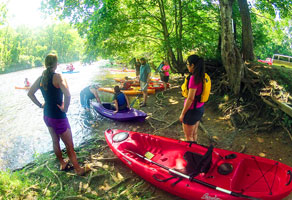
On shore
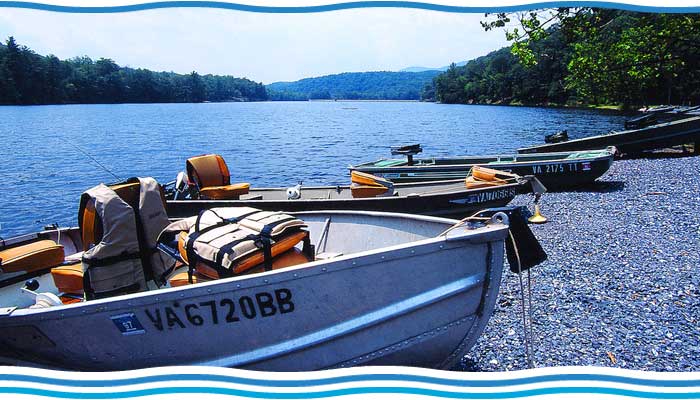
As with any water recreation, there are inherent risks. So, be smart and be safe. Know the rules and regulations for boating in Virginia and use good common sense.
Take the time to become familiar with your Personal Flotation Device (PFD). Test it in the water to make sure it supports your body and keeps your mouth and head clear of the water with no effort on your part. The law requires that a personal flotation device be in the boat for each person, but we recommend wearing it, especially when paddling on a river. Paddlers age 16 and under must wear their PFD at all times.
Avoid alcohol, which impairs the coordination and balance you need to control your boat on the river or lake. Boating and alcohol don’t mix, public display and consumption of alcohol on the rivers and lakes is also illegal. Save the drinks for after you get safely off the water
Always check the water levels before you paddle. Be cognizant of rain received in the watershed up river, which can take hours or days to flow through the Alleghany Highlands Blueway. High water levels create powerful currents and wave fields that can swamp and overturn boats. Avoid paddling when the water levels are above the Blueway’s recommended high water cut off. Low river may expose logs, stumps or rocks, which make the trip slower and more difficult to navigate. On the Jackson River, be aware that releases from the Gathright Dam can occur at any time and cause the river to rise unexpectedly. Always check release schedule from the Dam before you float the Jackson River. A daily recorded message regarding releases can be heard at 540-965-4117.
VIEW WATER LEVEL INFORMATION FOR:
Lake Moomaw >
Jackson River: Section 2 – Below Gathright Dam >
This stretch of river is passable when the water level is between 8.85 feet and 10 feet or river flow is between 200 CFS and 1000 CFS. Higher water may result in faster current or more rapids. Lower water may result in shallow water or exposed logs and rocks.
Jackson River: Section 3 – in Covington >
This stretch of river is passable when the water level is between 5.0 feet and 6.5 feet or river flow is between 500 CFS and 1900 CFS. Higher water may result in faster current or more rapids. Lower water may result in shallow water or exposed logs and rocks.
Cowpasture River >
This stretch of river is passable when the water level is between 2.0 feet and 4.0 feet or river flow is between 200 CFS and 1400 CFS. Higher water may result in faster current or more rapids. Lower water may result in shallow water or exposed logs and rocks.
Know where your float trip will take you, where to get out and obtain a river map of the section of river you will be paddling so you will know what to expect. Plan your trip so you will always be off the river before sunset. Be prepared for the difficulty of the river section you are about to paddle. Paddle water appropriate to your skills. If you are a novice, paddle with a friend that has experience or contact a local outfitter for your first trip.
Learn how to enter and exit your boat safely and stay low (kneel) in your boat when possible. Most paddle sports related drownings are the result of capsizing. Don’t over load your boat. Secure gear evenly.
Check weather conditions before launching your canoe/kayak (don’t go if the weather is beyond the abilities of the least experienced person in your group). Avoid paddling in cold weather. Stay alert to changing weather conditions while paddling. Get off of the water during electrical (lightning) storms.
A good rule of thumb is not to paddle when the combined air and water temperature is less than 110 degrees. Dress for the day and be prepared to get wet. If the weather is cool, dress warmly and bring an extra set of dry clothes sealed in a dry bag for emergency use.
Companions can come to your aid if you get in trouble. New paddlers should paddle with someone more experienced; it’s a great way to learn and remain safe if there is a mishap. File a “float plan” with a relative or friend so that someone knows where to find you and when you plan to return.
Be able to stop the boat at any time and know how to land on shore. Know how to boat forward, backward, and sideways using paddle strokes in various water conditions. Consider taking a canoe or kayak paddling class.
Be able to recognize river hazards such as submerged rocks, strainers (downed trees or branches reaching into the water); bridge pilings, big drop-offs, large waves, man made obstacles or debris, barbed wires across rivers, etc. Know how to safely navigate or carry your boat around these hazards.
Much of the land along the river bank is private property. Go ashore only on public areas or where you have permission to be. Please be respectful of Private Property.
Follow “Leave No Trace Ethic”. Don’t take glass bottles on the river as they can break and create a hazard for another paddler. Take along a trash bag and help us keep the river clean.
The Blueway closes at dusk as it is unsafe to navigate rapids at night.
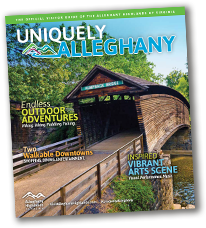
Sign up to receive
News & Updates >
Get the latest news and be the first to learn about new deals and events
Jul 1, 2025
Juneteenth Exhibit- Stalker of Light-a Tribute to Jada Callender
Jul 2, 2025
Juneteenth Exhibit- Stalker of Light-a Tribute to Jada Callender
Jul 3, 2025
Juneteenth Exhibit- Stalker of Light-a Tribute to Jada Callender